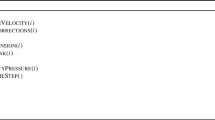Abstract
In this work we develop a numerical simulation of the spray coating of spinning beverage cans. Though the substrate of the can must be axisymmetric, the coating need not be. We start with an evolution equation, which was derived using scaling arguments and perturbation theory. We then use implicit finite differences and an ADI scheme, with periodic boundary conditions, to efficiently solve the problem numerically. The spray fan is modeled as an expanding ellipse, and we use parameters typical of the coating industry in our simulations. The simulations show that if the can rotates an exact integral number of rotations during the spray process, then the coating layer is almost axisymmetric. But when this cannot be achieved, then three-dimensional effects greatly change the coating dynamics of the thin liquid film and must be included in the analysis.




















Similar content being viewed by others
References
Weidner, DE, Schwartz, LW, Eley, R, "Numerical modeling of the spray coating of spinning bodies." J. Coat. Technol. Res., 16 (2) 363–376 (2018)
Weidner, DE, "Analysis of the flow of a thin liquid film on the surface of a rotating, curved, axisymmetric substrate." Phys. Fluids, 30 (082110) 1–8 (2018)
Conte, SD, Dames, RT, "On an alternating direction method for solving the plate problem with mixed boundary conditions." Appl. Math. Comput., 7 264–273 (1960)
Karawia, A, "A computational algorithm for solving penta-diagonal linear systems." Appl. Math. Comput., 174 (1) 613–618 (2006)
Emslie, AG, Bonner, FT, Peck, LG, "Flow of a viscous liquid on a rotating disk." J. Appl. Phys., 29 (5) 858 (1958)
Rehg, TG, Higgins, BG, "Spin coating of colloid suspensions." A. I. C. H. E. J., 38 (4) 489–501 (1992)
Peurrung, LM, Graves, DB, “Spin coating over topography.” Trans. Semicond. Manuf., 6 (1) 72–76 (1993)
Wilson, SK, Hunt, R, and Duffy, BR, "The rate of spreading in spin coating." J. Fluid Mech., 413 65–88 (2000)
Acrivos, A, Shah, MJ, Petersen, EE, "On the flow of a non-Newtonian liquid on a rotating disk." J. Appl. Phys., 31 963–968 (1984)
Lawrence, CJ, "The mechanics of spin coating of polymer films." Phys. Fluids, 31 (10) 2786–2795 (1988)
Jenekhe, SA, Schuldt, SB, "Coating flow of non-Newtonian fluids on a flat rotating disk." Ind. Eng. Chem. Fundam., 23 432–436 (1984)
Schwartz, LW, Roy, RV, "Theoretical and numerical results for spin coating of viscous liquids." Phys. Fluids, 16 (3) 569 (2004)
Fraysse, M, Homsey, GM, "An experimental study of rivulet instabilities in centrifugal spin coating of Newtonian and non-Newtonian fluids." Phys. Fluids, 6 1491 (1994)
Stillwagon, LE, Larson, RG, "Leveling of thin films over uneven substrates during spin coating." Phys. Fluids A Fluid Dyn., 2 (11) 1937 (1990)
Hwang, JH, Ma, F, "On the flow of a thin liquid film over a rough rotating disk." J. Appl. Phys., 66 388 (1989)
Spaid, MA, Homsy, GM, "Viscoelastic free-surface flows - spin-coating and dynamic contact lines." J. Nonnewton. Fluid Mech., 55 249–281 (1994)
Mahmoodi, S, Guoqing, M, Khajavi, MN, "Two-dimensional spin coating with vertical centrifugal force and the effect of artificial gravity on surface leveling." J. Coat. Technol. Res., 13 (6) 1123–1137 (2016)
Sahoo, S, Doshia, P, Orped, V, "Spreading dynamics of superposed liquid drops on a spinning disk." Phys. Fluids, 30 (1) 012110 (2018)
Sukanek, PC, "A model for spin coating with topography." J. Electrochem. Soc., 136 (10) 3019–3026 (1989)
Katranidis, V, Kamnis, S, Gu, S, "Prediction of coating properties of thermally sprayed WC-Co on complex geometries." J. Therm. Spray Technol., 27 (6) 1035–1037 (2018)
Tzinava, M, Delibasis, K, Allcock, B, Kamnis, S, "A general-purpose spray coating deposition software simulator." Surf. Coat. Technol., 399 126148 (2020)
Schwartz, LW, Weidner, DE, "Modeling of coating flows on curved surfaces." J. Eng. Math., 29 (1) 91–103 (1995)
Author information
Authors and Affiliations
Corresponding author
Additional information
Publisher's Note
Springer Nature remains neutral with regard to jurisdictional claims in published maps and institutional affiliations.
This paper was presented at the 2020 International Society of Coatings Science and Technology Conference that was held virtually September 20–23, 2020.
Appendix A: numerical scheme
Appendix A: numerical scheme
The functions \(\tilde{\mathrm{A}}\), \(\tilde{\mathrm{B}}\), \(\tilde{\mathrm{C}}\), \(\tilde{\mathrm{D}}\), and \(\tilde{\mathrm{E}}\) shall be defined explicitly in what follows. First we introduce the operators
and the definitions
where the subscript \(i+1/2\) means that the quantity is evaluated between the nodes i and \(i+1\). Using these operators we make the following definitions:
Rights and permissions
About this article
Cite this article
Weidner, D.E. Numerical modeling of the spray/spin coating of the interior of metal beverage cans: complete three-dimensional simulation. J Coat Technol Res 19, 97–109 (2022). https://doi.org/10.1007/s11998-021-00517-6
Received:
Revised:
Accepted:
Published:
Issue Date:
DOI: https://doi.org/10.1007/s11998-021-00517-6




